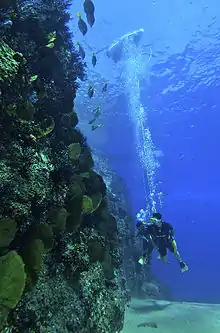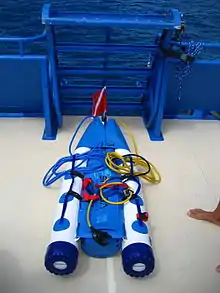Snuba
Snuba is form of surface-supplied diving that uses an underwater breathing system developed by Snuba International.[1] The origin of the word "Snuba" may be a portmanteau of "snorkel" and "scuba", as it bridges the gap between the two.[2] Alternatively, some have identified the term as an acronym for "Surface Nexus Underwater Breathing Apparatus",[3] though this may have been ascribed retroactively to fit the portmanteau. The swimmer uses swimfins, a diving mask, weights, and diving regulator as in scuba diving.[4] Instead of coming from tanks strapped to the diver's back, air is supplied from long hoses connected to compressed air cylinders contained in a specially designed flotation device at the surface.[5] Snuba often serves as a form of introductory diving, in the presence of a professionally trained guide, but requires no scuba certification.[6][7]
 Breathing air is supplied through hoses connected to compressed air cylinders on a raft at the surface. | |
| Other names | Hookah Airline diving |
|---|---|
| Uses | Surface supplied air system for shallow recreational diving |
| Manufacturer | Snuba International Inc |

Popularity
The snuba system was devised in 1989 by California diver Michael Stafford. It was then developed and patented in 1990 by Snuba International, based in Diamond Springs, California, who own the trademark and license it as a touring program.[8] Snuba diving is a popular guided touring activity in tropical tourist locations such as Hawaii, Thailand, the Caribbean and México.[5]
Snuba is also popular because no certification or prior dive experience is required. Participants need only to be at least eight years of age, have a basic swimming ability, and be comfortable in the water.[9] Its popularity as a first timer's experience can be attributed to several factors.
- The participant tows the raft on the surface via a lightweight harness connected to the air line. This gives the customer the secure knowledge that he/she cannot descend too deep and allows them to choose the depth that they feel most comfortable with while being able to control their depth, descent and ascent rates. By utilizing the hose as a guide, combined with wearing soft weights to achieve neutral buoyancy, participants are able to descend anywhere from just under the surface to 6 metres (20 ft) deep.[5]
- Participants are able to hold on to the raft at the surface using a lanyard that runs the length of the raft on both sides. This also allows the user to hold on to the raft while becoming comfortable breathing before beginning to descend. Being connected to the raft also provides users with a feeling of safety, comfort, and the option to hold on to the raft should they want to return to the surface.[5]
- Compared to scuba, snuba divers wear minimal gear. Each diver is equipped with a mask, fins, weight belt, harness and regulator. The harness holds the regulator and air line in place, allowing the diver to swim unencumbered beneath the surface.[1] This may be compared to full scuba gear, which includes a buoyancy compensator, weights, cylinder and often more, and can weigh in excess of 27 kilograms (60 lb).[10] Although scuba equipment is nearly weightless underwater, out of the water the weight becomes a significant factor for weaker individuals.[11][12] Unlike scuba divers, the snuba diver is not provided with an emergency buoyancy system, meaning that in case of emergency the snuba diver must reach the surface himself or await the arrival of assistance. On the other hand, a correctly weighted snuba diver will be neutrally buoyant at all depths (no compressible dive suit), has a hose and harness to prevent sinking, can pull on the hose to surface, which is less effort than swimming, and has a raft with a grab-rope to hold on to at the surface.
Disadvantages
In strong current, wave action, or breeze, the combination of underwater hose and surface raft can pull quite hard on a diver. Snuba is therefore best used in areas where wind, waves and current are negligible.[4] Since all snuba use is offered by licensed snuba operators who operate the systems as a guided tour, the possibility of being subjected to strong current, high waves or high wind is not likely. However it is beneficial if one employee of the snuba operator remains on the surface to monitor conditions.[13]
Since the depth of a snuba dive is limited to about 6 metres (20 ft), decompression sickness is not likely to be a problem.[14] However, as the snuba diver is breathing compressed air, there is still a risk of injury or death due to barotrauma, which is a more severe hazard at shallow depths if divers ascend as little as a few feet without venting the expanding air in their lungs. This danger is easily avoided by breathing normally and continuously while ascending. This point is thoroughly covered in snuba pre-dive briefings,[4] and monitored by the dive guide throughout the dive by watching for the continual release of bubbles from each diver. According to the snuba web site, since operation started in 1989, more than 5 million dives have been conducted without injury or fatality, but there appears to have been at least one fatality to a snuba diver,[15] in April 2014. The cause of death is not reported, so it is unknown if the death was related specifically to the use of snuba, or to other causes. It is not known if any other dives with injury or fatality have occurred. The snuba liability release form releases the operators and developers of the snuba system from any liability or responsibility for damage, injury or death due to neglect, system failure or any other reason.[16] Yet, there are many non-official reports about inadequate training.[17]
References
- "Snuba". Snuba International, Inc. 2006. Retrieved 2009-08-10.
- "SNUBA System". SNUBA. Archived from the original on 2018-03-28. Retrieved 2018-03-27.
- "SNUBA® on the Lani Kai". Maui Snorkeling. Retrieved 2018-03-27.
- Briley, John (1998-11-15). "Scuba on a Leash". washingtonpost.com: Style Live: Travel. Washington Post Company. Retrieved 2009-08-09.
- Jackson, Kristin (1995-01-22). "Snuba Diving Offers A Chance To Experience Rapture Of The Shallows". Seattle Times. Seattle Times Company. Retrieved 2009-08-10.
- Hoover, Pierce (March 1990). "Underwater Adventures". Popular Mechanics. Hearst Magazines: 98, 101. Retrieved 2009-08-10.
- "SNUBA Lets Novices Dive Without Tanks". nl.newsbank.com. Palm Beach Post. 1994-06-19. Retrieved 2009-08-10.
- "United States Patent: Underwater Diving System". USPTO Patent Full-Text and Image Database. 1990-04-24. Retrieved 2009-08-10.
- Tsutsumi, Cheryl (2007-06-17). "Snuba Tours Open Underwater World To Everyone". archives.starbulletin.com. Star Bulletin. Retrieved 2009-08-10.
- "Introduction To Scuba Equipment". PADI. 2008. Retrieved 2009-08-11.
- Gerber, Suzanne (2006). "Got back pain?" (PDF). Alert Diver. Divers Alert Network. Retrieved 2011-08-30.
- Martz, Cameron L. "Dealing with Heavy Scuba Gear". DiveFitness.com. Retrieved 2011-08-30. Cite journal requires
|journal=(help) - "Snuba Diving in the Caribbean (What is Snuba?)". Caribbean Magazine. Retrieved 2009-08-11.
- Van Liew, HD; Flynn, ET (2005). "Direct ascent from air and N2-O2 saturation dives in huma ns: DCS risk and evidence of a threshold". Undersea and Hyperbaric Medicine. 32 (6): 409–19. PMID 16509283. Retrieved 2009-03-11.
- "Scubaboard discussion forum". Retrieved June 16, 2014.
- "Snuba Liability Release form" (PDF). Retrieved March 22, 2011.
- "Snuba bad idea". ScubaMonster forums. Archived from the original on July 24, 2008.CS1 maint: unfit URL (link)
External links
| Wikimedia Commons has media related to Snuba diving. |
| Wikivoyage has a travel guide for SNUBA. |
- www.snuba.com — Snuba International, Inc.
